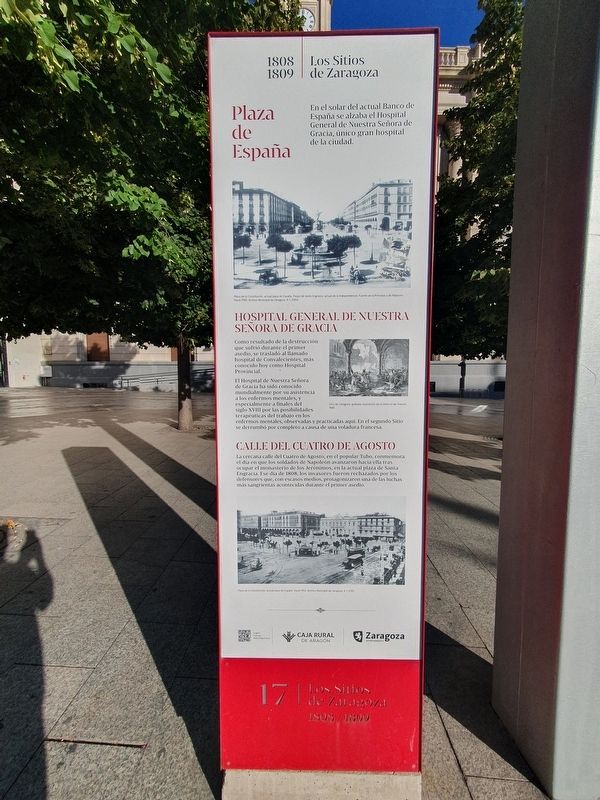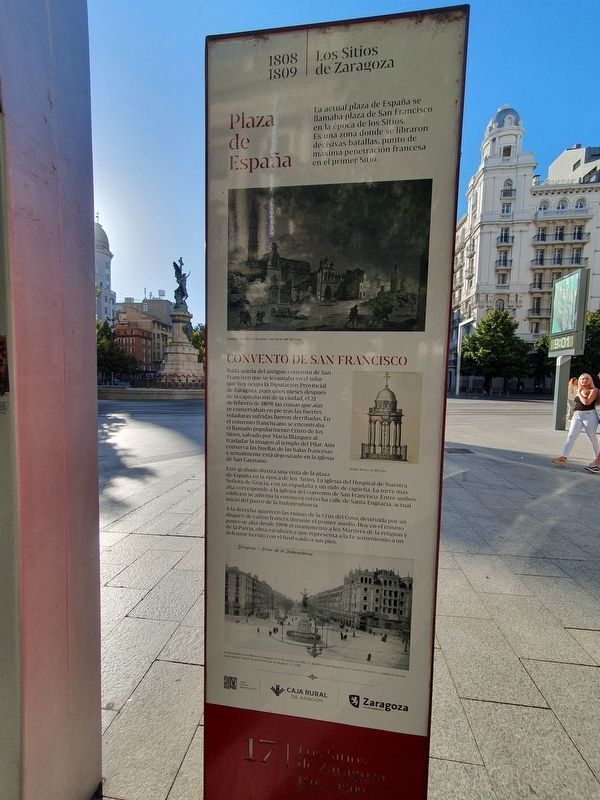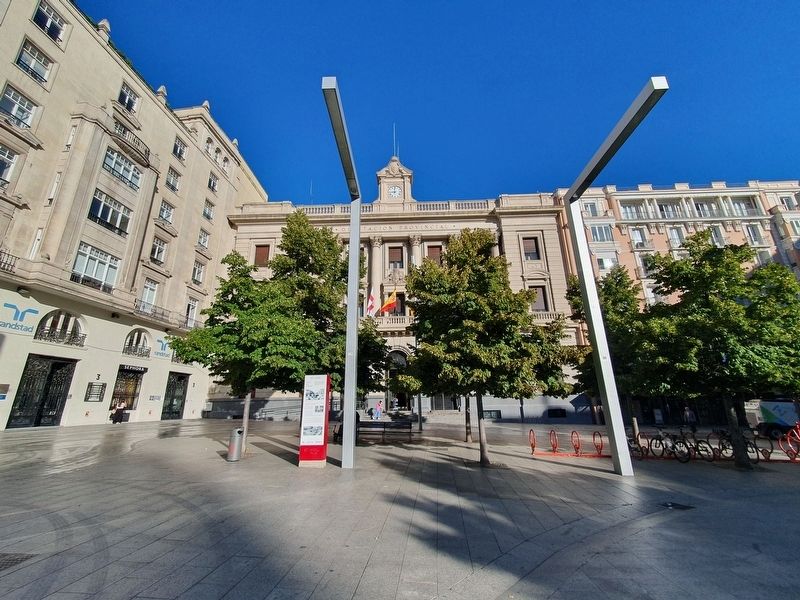Casco Antiguo in Zaragoza, Aragón, Spain — Southwestern Europe (Iberian Peninsula)
Plaza de España
1808 · 1809 Sitios de Zaragoza
La actual plaza de España se llamaba plaza de San Francisco en la época de los Sitios. Es una zona donde se libraron decisivas batallas, punto de máxima penetración francesa en el primer Sitio.
Convento de San Francisco
Nada queda del antiguo convento de San Francisco que se levantaba en el solar que hoy ocupa la Diputación Provincial de Zaragoza, pues unos meses después de la capitulación de la ciudad, el 21 de febrero de 1809, las ruinas que aún se conservaban en pie tras las fuertes voladuras sufridas fueron derribadas. En el convento franciscano se encontraba el llamado popularmente Cristo de los Sitios, salvado por María Blázquez al trasladar la imagen al templo del Pilar. Aún conserva las huellas de las balas francesas y actualmente está depositado en la iglesia de San Cayetano.
Este grabado ilustra una vista de la plaza de España en la época de los Sitios. La iglesia del Hospital de Nuestra Señora de Gracia, con su espadaña y un nido de cigüeña. La torre más alta corresponde a la iglesia del convento de San Francisco. Entre ambos edificios se adivina la entonces estrecha calle de Santa Engracia, actual inicio del paseo de la Independencia.
A la derecha aparecen las ruinas de la Cruz del Coso, destruida por un disparo de cañón francés durante el primer asedio. Hoy en el mismo punto se alza desde 1908 el monumento a los Mártires de la religión y de la Patria, obra escultórica que representa a la Fe sosteniendo a un defensor herido con el fusil caído a sus pies.
Plaza de España
En el solar del actual Banco de España se alzaba el Hospital General de Nuestra Señora de Gracia, único gran hospital de la ciudad.
Hospital General de Nuestra Señora de Gracia
Como resultado de la destrucción que sufrió durante el primer asedio, se trasladó al llamado hospital de Convalecientes, más conocido hoy como Hospital Provincial.
El Hospital de Nuestra Señora de Gracia ha sido conocido mundialmente por su asistencia a los enfermos mentales, y especialmente a finales del siglo XVIII por las posibilidades terapéuticas del trabajo en los enfermos mentales, observadas y practicadas aquí. En el segundo Sitio se derrumbó por completo a causa de una voladura francesa.
Calle del Cuatro de Agosto
La cercana calle del Cuatro de Agosto, en el popular Tubo, conmemora el día en que los soldados de Napoleón avanzaron hacia ella tras ocupar el monasterio de los Jerónimos, en la actual plaza de Santa Engracia. Ese día de 1808, los invasores fueron rechazados por los defensores que, con escasos medios, protagonizaron una de las luchas más sangrientas acontecidas durante el primer asedio.
Pie de dibujos
Grabado de Gálvez y Brambila. Vista de la calle del Coso.
Alzado de la Cruz del Coso.
El Monumento a los Mártires se inauguró el 23 de octubre de 1904. Lo diseñó Ricargo Magdalena y el conjunto escultórico, fundido en bronce, es de Agustín Querol. Archivo Municipal de Zaragoza, 4-1_0148.
Plaza de la Constitución, actual plaza de España. Paseo de Santa Engracia, actual de la Independencia. Fuente de la Princesa o de Neptuno. Hacia 1900. Archivo Municipal de Zaragoza, 4-1_0454.
Sitio de Zaragoza, grabado ilustración de la Historia de Francia. 1885.
Plaza de la Constitución, actual plaza de España. Hacia 1902. Archivo Municipal de Zaragoza, 4-1_0190.
Spain Square
The curent name of the Square called Plaza de España was formerly the Plaza de San Francisco at the time of the Sieges. It is a zone where decisive battles took place, the maximum penetration point by the Frenchin the first Siege.
Convent of San Francisco
Nothing remains of the old Convent of San Francisco which was built on the plot now occupied by the Provincial Council of Zaragoza, since several months after the capitulation of the city on 21 February, the ruins which still remained standing after the major blasts it had undergone were demolished. The Franciscan convent housed the popularly known “Cristo de los Sitios” (Christ of the Sieges), rescued by María Blázquez who moved the statue to El Pilar temple. The marks of the French bullets are still conserved and it is currently deposited in the church of San Cayetano.
This engraving illustrates a view of the Plaza de España at the time of the Sieges. The church called Iglesia del Hospital de Nuestra Señora de Gracia, with its steeple and a stork’s nest. The highest tower corresponds to the church of the San Francisco convent. Between both buildings, there is a glimpse of the formerly narrow street called Calle de Santa Engracia, where the Promenade now called Paseo de la Independencia begins. The ruins of the Coso Cross are shown on the right, destroyed by a shot from a French cannon during the first siege. Since 1908, there is a monument to the “Martyrs of Religion and the Country”, a sculptural work which represents Faith holding a wounded defender with a fallen rifle at her feet.
Spain Square
The Hospital de Nuestra Señora de Gracia has been internationally acclaimed for its care to mentally ill patients, especially at the end of the 18th century due to the therapeutic possibilities of working with mentally ill patients, which were observed and practised here.
Hospital General de Nuestra Señora de Gracia
In the plot of the current Bank de España (Bank of Spain), the Hospital General de Nuestra Señora de Gracia was built, the city’s only large hospital. As a result of the destruction which it underwent during the first siege, the patients were transferred to the Hospital de Convalecientes (Convalescent Hospital), which is better known today as the Provincial Hospital. In the second Siege, it completely collapsed due to a French blast.
Fourth of August Street
The nearby street called Calle del Cuatro de Agosto, in the popular Tube, commemorates the date on which Napoleon’s soldiers advanced toward it after occupying the Monastery of los Jerónimos, in the current square, Plaza de Santa Engracia. On that date in 1808, the French invaders were repulsed by the defenders, who, with scarce resources, participated in one of the bloodiest battles that took place during the first siege.
Captions
Grabado de Gálvez y Brambila. Vista de la calle del Coso.
Alzado de la Cruz del Coso.
The Monument to the Martyrs was inaugurated on 23 October 1904. It was designed by Ricardo Magdalena and the set of bronze cast sculptures is by Agustín Querol. Archivo Municipal de Zaragoza, 4-1_0148.
Plaza de la Constitución (Constitution Square), now called “Plaza de España”. Santa Engracia Promenade, now called “Paseo de la Independencia”. Princess or Neptune Fountain. Approx. 1900. Archivo Municipal de Zaragoza, 4-1_0454.
Sitio de Zaragoza, grabado ilustración de la Historia de Francia. 1885.
Plaza de la Constitución (Constitution Square), now called “Plaza de España”. Approx. 1902. Archivo Municipal de Zaragoza, 4-1_0190.
Erected by Ayuntamiento de Zaragoza. (Marker Number 17.)
Topics. This historical marker is listed in these topic lists: Parks & Recreational Areas • Wars, Non-US. A significant historical date for this entry is October 23, 1904.
Location. 41° 39.124′ N, 0° 52.886′ W. Marker is in Zaragoza, Aragón. It is in Casco Antiguo. Marker is on Paseo de la Independencia, on the right when traveling south. Touch for map. Marker is at or near this postal address: Pº de la Independencia 9, Zaragoza, Aragón 50001, Spain. Touch for directions.
Other nearby markers. At least 8 other markers are within walking distance of this marker. A different marker also named Plaza de España (a few steps from this marker); Monument to the Martyrs to Religion and the Nation (within shouting distance of this marker); José Sinués y Urbiola (about 180 meters away, measured in a direct line); Calle San Diego (about 180 meters away); Plaza de Santiago Sas (about 210 meters away); Calle de Don Alfonso I (about 210 meters away); Santiago Ramón y Cajal (approx. 0.2 kilometers away); Pedro María Ric y Monserrat (approx. 0.3 kilometers away). Touch for a list and map of all markers in Zaragoza.
Also see . . . Plaza de España. The Ayuntamiento de Zaragoza maintains this website with Spanish, English and French versions of the markers in this series on the Sieges of Zaragoza in 1808 and 1809. (Submitted on November 8, 2023.)
Credits. This page was last revised on November 8, 2023. It was originally submitted on November 8, 2023, by J. Makali Bruton of Accra, Ghana. This page has been viewed 43 times since then and 11 times this year. Photos: 1, 2, 3. submitted on November 8, 2023, by J. Makali Bruton of Accra, Ghana.


